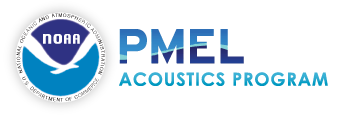| SOund SUrveillance System (SOSUS): General Information |
In October, 1990, the Navy granted approval to NOAA/PMEL to access the SOSUS arrays in the North Pacific to assess their value in ocean environmental monitoring, as part of the U.S. government's dual-use initiative.
The data collection systems developed by NOAA's Acoustics Program have been in place since August 29, 1991. Acoustic signals from the north Pacific Ocean are monitored and recorded at the Newport, Oregon facility of NOAA/PMEL. This is the primary tool for both continuous monitoring of low-level seismicity around the northeast Pacific Ocean and real-time detection of volcanic activity along the northeast Pacific spreading centers in support of the Acoustics research program in ocean hydrothermal systems. Real-time ridge crest monitoring potentially permits the timely on-site investigation of hydrothermal and magmatic emissions.
Data acquisition is accomplished by combining portions of the Navy's processing facilities with NOAA-designed systems installed at the U.S. Naval Ocean Processing Facility (NOPF) at Whidbey Island, Washington. Raw analog outputs from specific hydrophones are accessed by NOAA-supplied systems, where the signals are low-pass filtered, digitized, and temporarily buffered on hard disk. The digital data are provided to a wide-area network (WAN) based on Network File System (NFS) protocol, linking (by encrypted, dedicated telephone line) the acquisition computer to an analysis system located at NOAA laboratories in Newport, Oregon. |
||||
